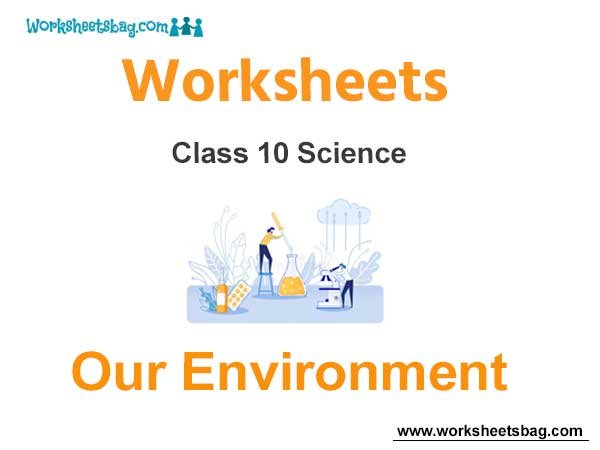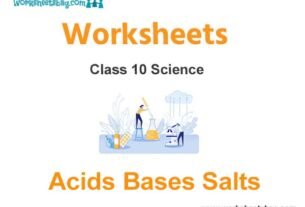Students should refer to Worksheets Class 10 Science Our Environment Chapter 15 provided below with important questions and answers. These important questions with solutions for Chapter 15 Our Environment have been prepared by expert teachers for Class 10 Science based on the expected pattern of questions in the class 10 exams. We have provided Worksheets for Class 10 Science for all chapters on our website. You should carefully learn all the important examinations questions provided below as they will help you to get better marks in your class tests and exams.
Our Environment Worksheets Class 10 Science
Question. It which of the following devices CFC’s are not produced?
(a) Refrigerators
(b) Fire extinguishers
(c) Pressurized cans
(d) Pencil
Answer
D
Question. Which of the following is an example non-biodegradable substance?
(a) Virgin plastic
(b) Plastic
(c) Plants
(d) Plant products
Answer
B
Question. Which of the following is the full form of CFC?
(a) Chlorofluorine carbon
(b) Carbonchlorofluorine
(c) Chlorinfluid carbon
(d) Chlorofluorocarbon
Answer
D
Question. Which of the following is not an example of abiotic factors?
(a) Light
(b) Plants
(c) Heat
(d) Temperature
Answer
B
Question. Which of the following actions may not affect the environment in worse?
(a) Plastic bags buried inside the earth.
(b) Planting of trees
(c) Excessive use of non-biodegradable pesticides
(d) Burning of plastic bags.
Answer
B
Question. Which of the following is a functional unit of environment?
(a) Ecosystem
(b) Nitrogen
(c) Carbon
(d) Oxygen
Answer
A
Question. Which of the following in not an effect of ultraviolet radiations?
(a) Causes skin cancer
(b) Causes sun burn
(c) Causes eye disease
(d) Causes typhoid
Answer
D
Question. Which of the following is an example of producers?
(a) Plastic pens
(b) Plastic cans
(c) Polythene
(d) Green plants
Answer
D
Question. Which of the following is an example of herbivores?
(a) Cow
(b) Shark
(c) Lion
(d) Tiger
Answer
A
Question. Which of the following is an example of food chain?
(a) Grass → Deer → Lion
(b) Algae → Diatoms → Fish
(c) Fish → Deer → Algae
(d) Grass → Frog → Birds
Answer
A
Question. Which of the following is the formula of ozone?
(a) O3
(b) O2
(c) O4
(d) O6
Answer
A
Question. Which of the following constituents do not form ecosystem?
(a) Biotic constituents
(b) Plastic bags
(c) Abiotic constituents
(d) All of these
Answer
B
Question. Which of the following is the full form of UNEP?
(a) United Kingdom of Africa
(b) United State of America
(c) United Nations Environment programme
(d) Union English programme
Answer
C
Question. Which of the following is not a biodegradable pollutant?
(a) Paper
(b) Cotton cloth
(c) Cotton
(d) DDT
Answer
D
Question. Which of the following is terrestrial ecosystem?
(a) A natural forest
(b) A lake
(c) A pond
(d) An aquarium
Answer
A
Question. Name the thing in our body which helps us to digest food?
(a) hormone
(b) enzymes
(c) stomach
(d) mouth
Answer
B
Question. Which human-made material cannot be broken down by the action of bacteria?
(a) human flesh
(b) flesh of dead animal
(c) vegetable peels
(d) plastic
Answer
D
Question. Which of the following belong to same trophic level?
(a) Cockroach and spider
(b) Lizard and spider
(c) Hawk and spider
(d) Lizard and hawk.
Answer
D
Question. Which of the following is an example biodegradable substance?
(a) Glass
(b) Plants
(c) Plastics
(c) Polythene
Answer
B
Question. Which of the following is omnivore?
(a) Lion
(b) Hawks
(c) Jackal
(d) Man
Answer
D
Question. Which of the following is proper sequence of trophic levels?
(a) Producers, Herbivores, Top carnivores, Carnivores
(b) Top Carnivores, Carnivores, Herbivores, Producers
(c) Carnivores, Top Carnivores, Producers, Herbivores
(d) Herbivores, Carnivores, Producers, Top Carnivores
Answer
B
Question. How many atoms of oxygen are there in ozone?
(a) 3
(b) 4
(c) 2
(d) 1
Answer
B
Question. Which of the following is an example of human made ecosystem?
(a) Aquarium
(b) Sunlight
(c) Wind
(d) Water
Answer
B
Question. What is the nature of ozone?
(a) It is deadly poisonous
(b) It is fragrant
(c) It is smooth
(d) It causes purple smoke
Answer
B
Question. By which way autotrophs convert energy of food?
(a) Solar energy to chemical energy
(b) Bio-gas to chemical energy
(c) solar energy to bio-gas
(d) Chemical energy to solar energy
Answer
B
Question. Which of the following groups contain only biodegradable items?
(a) Grass, flowers and leather
(b) Grass, wood and plastic
(c) Fruit-peels, cake and lime-juice
(d) Cake, wood and grass
Answer
(a), (c) and (d).
Question. Which of the following constitute a food-chain?
(a) Grass, wheat and mango
(b) Grass, goat and human
(c) Goat, cow and elephant
(d) Grass, fish and goat
Answer
B
Question. Which of the following are environment-friendly practices?
(a) Carrying cloth-bags to put purchases in while shopping
(b) Switching off unnecessary lights and fans
(c) Walking to school instead of getting your mother to drop you on her scooter
(d) All of the above
Answer
D
Question. The percentage of solar radiation absorbed by all the green plants for the Process of photosynthesis is about-
(a) 1%
(b) 8%
(c) 5%
(d) 10%
Answer
A
Question. Which of the following limits the number of trophic levels in a food chain?
(a) Water
(b) Polluted air
(c) Deficient food supply
(d) Decrease in energy at higher trophic levels
Answer
D
Question. In natural ecosystems, decomposers include-
(a) Only bacteria and fungi
(b) Only microscopic animals
(c) Herbivores and carnivores
(d) Both (b) and (c)
Answer
A
Question. What will happen if deer is missing in the given food chain? Grass Deer Tiger
(a) The population of tiger decreases and the population of grass increases
(b) The population of grass decreases
(c) Tiger will start eating grass
(d) The population of tiger increases
Answer
A
Question. Flow of energy in an ecosystem is always-
(a) Unidirectional
(b) Bidirectional
(c) Multidirectional
(d) No specific direction.
Answer
A
Question. ASSERTION (A): Decomposers act as cleaning agents of environment.
REASON(R): The decomposers recycle waste material in hydrosphere.
(a) Both A and R are true and R is the correct explanation for A
(b) Both A and R are true and R is not the correct explanation for A
(c) A is true but R is false
(d) A is false but R is true.
Answer
C
Question. ASSERTION (A):Garden is an artificial ecosystem.
REASON(R): Biotic and abiotic components are manipulated by humAnswer:
(a) Both A and R are true and R is the correct explanation for A
(b) Both A and R are true and R is not the correct explanation for A
(c) A is true but R is false
(d) A is false but R is true.
Answer
B
Very Short Answer Type Questions
Question. Name any two groups of producers.
Answer : Plants and blue-green algae.
Question. Name two decomposers.
Answer : Bacteria and fungi
Question. Expand UNEP
Answer : United Nations Environment Programme.
Question. Write the two raw materials for making food, used by living organisms of first tropic level.
Answer : CO2 and Water
Question. Define biological magnification.
Answer : The accumulation of chemicals in the bodies of the organism that belongs to the top most tropic level is called biological magnification.
Question. What are consumers in the food chain?
Answer : Those organisms which consume the food produced either directly from producers or indirectly by feeding on other organisms are called consumers.
Short Answer Type Questions
Question. Why is plastic bag called non-biodegradable while paper is not?
Answer : Plastic bag is not acted upon by decomposers as it cannot be broken down into simple components, so it is called non-biodegradable while paper gets decomposed.
Question. What are the two main components of our environment?
Answer : Biotic (living components) ⎯⎯→ Plants, animals
Abiotic (non-living components) ⎯⎯→ Water, air
Question. Which compounds are responsible for the depletion of ozone layer?
Answer : Chlorofluorocarbons (CFC)
Question. Pesticides are useful to farmers yet considered as pollutants. Give reasons.
Answer : Pesticides kill insects and pests thereby protecting the crops but these pesticides remain on the crops which enter the food chain and gets accumulated in the organisms and reaches the top most trophic level that causes diseases. When washed away by rain, it causes pollution of water.
Question. State different types of consumers in an ecosystem.
Answer : The consumers are herbivores, carnivores, omnivores, parasites, saprophytes and decomposers.
Question. Differentiate between biodegradable and non biodegradable substances.
Answer : Biodegradable: These substances can be broken down by the action of saprotrophs and other agents, e.g., paper, cloth.
Non biodegradable: These substances cannot be broken down by the action of saprotrophs, e.g., glass, plastics.
Question. How is ozone layer important to us?
Answer : Ozone is a pollutant at lower level of atmosphere but is very useful in shielding harmful UV rays. This layer is present in the stratosphere.
In absence of ozone layer heavy damage to organism may occur e.g. skin cancer, cataract etc.
Question. Which disease is caused in human beings due to depletion of ozone layer in the atmosphere?
Answer : Skin cancer, cataract.
Question. What is causing the damage to ozone layer?
Answer : The CFC emission due to various industrial activities has caused damage to the Ozone layer and has contributed to global warming by allowing a major portion of UV rays to reach the earth’s atmosphere through ozone holes.
Question. Define an ecosystem. Explain in detail about its various components.
Answer : Ecosystem is defined as a well defined unit or area in an environment where biotic and abiotic components interact with each other to maintain balance in nature.
Biotic components – producers, consumers, saprotrophs.
Abiotic components – air, water, sunlight.
Question. What is a food chain? List its characteristics features.
Answer : Food chain is defined as the phenomenon of transfer of energy through series of organisms falling on successive trophic levels.
Example: sun is the ultimate source of energy. Producers or green plants
photosynthesize and utilize solar energy. Thereafter the energy is transferred to other successive levels.
Food chain can be depicted as follows:
Plants → grasshopper → frog → snake → decomposers
Question. Differentiate between natural and artificial ecosystem.
Answer :
| Natural ecosystem | Artificial ecosystem |
| Naturally occurring ecosystem. E.g., pond, grassland, forest | These are man-made ecosystem. E.g., garden, aquarium, crop-field. |
Long Answer Type Questions
Question. What are trophic levels? Give an example of a food chain and state the different trophic levels in it.
Answer : The various levels or stages in a food chain at which the transfer of food takes place
is called trophic level, e.g., food chain.
Grass → Grasshopper → frog → snake → peacock
Grass — Producer — I trophic level.
Grasshopper — I Consumer (Herbivores) — II trophic level.
Frog — II Consumer (Carnivores) — III trophic level
Snake — III Consumer (Carnivores) — IV trophic level
Peacock — IV Consumer (Carnivores) — V trophic level.
Question. What is the role of decomposers in the ecosystem?
Answer : Decomposers breakdown the complex organic substances like plant’s and animal’s dead body and convert them into simpler inorganic substances.
All the elements that are present in the body on which decomposers act is released back to the nature. Decomposers maintain balance in the nature and plays an important role in the environment.
Question. What is biological magnification? Explain giving one example.
Answer : The accumulation of chemicals in the top most organism of the trophic level or food chain is called biological magnification.
Example: Farmer sprays pesticides on the crops which enters the food chain, from crops these pesticides enter into the organisms that feed on it.
grass ⎯⎯→ grasshopper ⎯⎯→ frog ⎯⎯→ snake ⎯⎯→ hawk
In this food chain the maximum amount of pesticide will be found in the top most organism i.e., in hawk the chemical keeps accumulating.
Question. What are decomposers? How are they important for the ecosystem?
Answer : Decomposers are the organisms which act on dead organisms to decompose the body so as to release all the elements back to nature.
They act as cleansing agents, hence they are important in the ecosystem.
Question. What is the importance of ozone in the environment why is it depleting? What precautions are taken to preserve it?
Answer : Ozone is present in the stratosphere. It protects the earth from harmful ultraviolet radiations. UV ray causes various diseases to organisms e.g. skin cancer, cataract in human beings.
Ozone layer is depleting because of chlorides and fluorides. They act on ozone molecules and deplete it. Chlorides, fluorides are present in CFC’s which are used in refrigerants and fire extinguishers.
CFC ⎯⎯→ Chlorofluorocarbon
The precautions taken to preserve the ozone layer is to ban the use of CFC’s.
Question. What are food-chains and food webs? Why are smaller food chains better? What is 10% flow?
Answer : Food chain: The flow of food from sun to autotrophs, from autotrophs to herbivores and from herbivores to carnivores is called food chain. A food chain can have two levels or five to six levels also.
Food web: When an organism is eaten by two or more other kinds of organisms, instead of straight chain an interlinked chain is formed, is termed as food web.

Smaller the food chain the energy available for the next level of consumer in such a chain is more. As the loss of energy at each step takes place and very little energy is left after four trophic levels.
The green plants in terrestrial ecosystem capture about 1% of the sun’s energy and convert it into food energy. When green plants are eaten by primary consumers—a great deal of energy is lost for the life processes and only 10% of the energy is available for the next level of consumers.
Question. “Damage to the ozone layer is a cause of concern”. Justify this statement suggest any two steps to limit this damage.
Answer : Ozone is a molecule of oxygen with 3 atoms i.e., O3. It is formed due to sunlight at higher levels with higher wavelength.
O2 —→UV rays O + O
O2 + O ⎯⎯→ O3(Ozone)
Ozone is found in stratosphere shielding the earth by protecting it and by not allowing UV rays to reach the earth.
If these rays will reach the earth then many harmful diseases are caused like skin cancer, cataract, it also affects the growth of plants and vegetation.
Two steps to limit the damage of this layer are:
(i) Do not use aerosols, or any products which will release CFC (chlorofluorocarbon) in the atmosphere.
(ii) Ban on use of CFC as refrigerant and in fire extinguishers.
Question. Distinguish between biodegradable and non-biodegradable substances. List two effects of each of them on our environment.
Answer :
| Biodegradable substance | Non-biodegradable substance |
| 1. Substances can be decomposed by micro-organisms 2. Do not get accumulated in environment. 3. Do not cause any pollution | 1. Substances cannot be 2. decomposed by micro-organisms. It gets accumulated in environment. 3. It causes pollution. |
Two effects on environment.
| (i) Releases foul smell while decomposing in surrounding areas. | (i) It gets accumulated causing water and soil pollution and causes biological magnification. |
| (ii) It acts as a breeding ground for insects. | (ii) It disturbs the ecosystem by interfering in the food chain and killing many animals. |
Question. All eco-club students collect the vegetable peels from canteen and use them in compost pit made in their school.
(a) Name items that can be added in compost pit other than vegetable peels.
(b) What type of reaction is seen in the pit?
(c) State the values seen among eco-club members.
Answer : (a) Students can use leftover food and fruit peels, dried leaves.
(b) Fermentation i.e., anaerobic decomposition.
(c) The eco-club students show team work, collaborative work and good behaviour.
Question. What are the problems caused by the non-biodegradable waste that we generate?
Answer : (i) As the non-biodegradable waste cannot be broken down into simpler forms hence they keep on accumulating in nature causing pollution.
(ii) They cause diseases.
(iii) It also causes biological magnification.
Question. If all the waste we generate is bio-degradable, will this have no impact on the environment?
Answer : If all the waste we generate is bio-degradable and is managed in such a way that it is allowed to decompose then it will have no impact on the environment.
Question. Why is damage to the ozone layer a cause for concern? What steps are being taken to limit this damage?
Answer : Ozone layer in the strastosphere is very helpful in shielding harmful UV rays. In absence of ozone layer heavy damage to organism may occur. It may cause diseases like skin cancer, cataract, reduced crop production etc.
The damage is limited by UNEP (United Nations Environment Programme), it has forged an agreement to freeze for CFC production in 1986.
CFC– Chlorofluorocarbons used as refrigerants and in fire extinguishers.


